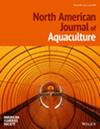光照、饲养密度和鱼体大小对养殖鳞鱼幼鱼的影响
IF 1.4
4区 农林科学
Q3 FISHERIES
引用次数: 0
摘要
目标:由于鳞鱼是鲑鱼海洋养殖中的清洁鱼类,市场对鳞鱼的需求量很大,因此有必要提高鳞鱼的孵化产量和饲养效率。生产瓶颈之一是由于攻击性行为(包括食人)造成的幼鱼损失。有必要了解哪些因素会加剧鳞鱼的攻击性,并为水产养殖者提供缓解指南。方法2022年,在3升水族箱中进行了两次为期8周的实验,在不同的光周期制度(12小时光照:12小时黑暗[113 lx];24小时光照:0小时黑暗[21 lx];24小时光照:0小时黑暗[302 lx])下,对不同规格等级(4克和11克)的幼鱼进行了三种饲养密度(40、65和90克/升)的饲养,共进行了9种实验处理。结果对于 4 克鳞鲈,光照和密度对生长(增重和特定生长率)有显著影响,而光照和密度之间的交互作用会显著影响咬尾鳍的发生,但不会影响咬鳍的程度或存活率。所测试的变量均未对体重为 11 克的鱼产生明显影响。总体而言,小鱼的尾鳍咬合率呈上升趋势(4 克鱼的咬合率约为 45%,而 11 克鱼的咬合率约为 20%),这表明小于 4 克的团头鲂的食人现象可能更为严重,但随着鱼体的长大,食人现象会逐渐减少。对于小型(约 4 克)鳞鱼,建议将恒定的低光照强度与低(40 克/升)饲养密度相结合,以减少生长和尾鳍撕咬。但是,随着体长的增长,这些变量对鱼类生长的影响就会减弱。本文章由计算机程序翻译,如有差异,请以英文原文为准。
The effects of light, rearing density, and fish size in culturing juvenile Lumpfish
ObjectiveThere is an impetus for increasing Lumpfish Cyclopterus lumpus hatchery production and rearing efficiency due to the high demand for their usefulness as cleaner fish in salmonid ocean farming. One production bottleneck is the loss of juvenile fish due to aggressive behaviors, including cannibalism. Understanding which factors exacerbate Lumpfish aggression and providing mitigation guidelines to aquaculturists are warranted.MethodsTwo experiments were conducted for an 8‐week period in 2022 in 3‐L aquaria with different juvenile size‐classes (4 and 11 g) subjected to three rearing densities (40, 65, and 90 g/L) under different photoperiod regimes (12 h light : 12 h dark [113 lx]; 24 h light : 0 h dark [21 lx]; and 24 h light : 0 h dark [302 lx]), resulting in nine experimental treatments. Survival, growth, and aggression (occurrence and severity of caudal fin nipping) were evaluated.ResultFor 4‐g Lumpfish, light and density significantly affected growth (weight gain and specific growth rate), while an interaction between light and density significantly affected the occurrence of caudal fin nipping but not the degree of fin nipping or survival. None of the tested variables significantly affected 11‐g fish. Generally, a trend toward increased caudal fin nipping occurred in smaller fish (~45% occurrence in 4‐g fish vs. ~20% in 11‐g fish), indicating that cannibalism may be even greater when Lumpfish are smaller than 4 g but abates as the fish grow.ConclusionOur findings indicate that manipulation of lighting at rearing densities of up to 90 g/L can be used to control growth rates in small Lumpfish, often without resulting in increased fish aggression. For small (~4‐g) Lumpfish, constant low light intensity in combination with a low (40‐g/L) rearing density is recommended for reducing growth and caudal fin nipping. However, as Lumpfish grow, these variables are less effective at manipulating fish growth.
求助全文
通过发布文献求助,成功后即可免费获取论文全文。
去求助
来源期刊
CiteScore
2.50
自引率
0.00%
发文量
46
审稿时长
18-36 weeks
期刊介绍:
The North American Journal of Aquaculture publishes papers on new research and practical experience in all areas of intensive and extensive fish culture. Topics include broodstock selection and spawning, nutrition and feeding, health and water quality, facilities and production technology, and the management of ponds, pens, and raceways.
The journal will consider papers dealing with ways to improve the husbandry of any aquatic species—marine or freshwater, vertebrate or invertebrate—raised for commercial, scientific, recreational, enhancement, or restoration purposes that may be of interest to practitioners in North America. Its scope includes both basic and applied science, but applied scientific endeavors—including practical experiences, descriptive studies, and other nontraditional, but pertinent works—are emphasized.

 求助内容:
求助内容: 应助结果提醒方式:
应助结果提醒方式:


